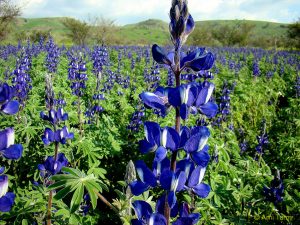 March is surprising every year, presenting nature in all its glory. The eyes wander between shapes and colors and the heart tries to select the one flower, out of all, that captures the soul. This time I chose a flower that looks as if it assigned itself to cover the sides of the roads with blue outstanding blossom carpets – that is the Lupinus Pilosus, commonly known as the blue lupine. The Blue Lupinus Pilosus carpets phenomenon has gradually spread throughout the years in the Mediterranean region of the Holy Land. The Lupinus Pilosus is not limited to a certain soil apart from rock and calcite. It is also found on Rendzina soil in Ramat Menashe, on the basalt cover of the Tavor River, near Moshav Hemdat in the northern Jordan Valley, and elsewhere. The Lupinus Pilosus carpets abundant in ancient barrows are filled with organic material created over thousands of years. An example of this is Tel Sokho in the Elah Valley.
March is surprising every year, presenting nature in all its glory. The eyes wander between shapes and colors and the heart tries to select the one flower, out of all, that captures the soul. This time I chose a flower that looks as if it assigned itself to cover the sides of the roads with blue outstanding blossom carpets – that is the Lupinus Pilosus, commonly known as the blue lupine. The Blue Lupinus Pilosus carpets phenomenon has gradually spread throughout the years in the Mediterranean region of the Holy Land. The Lupinus Pilosus is not limited to a certain soil apart from rock and calcite. It is also found on Rendzina soil in Ramat Menashe, on the basalt cover of the Tavor River, near Moshav Hemdat in the northern Jordan Valley, and elsewhere. The Lupinus Pilosus carpets abundant in ancient barrows are filled with organic material created over thousands of years. An example of this is Tel Sokho in the Elah Valley.
The enigma of the Lupinus Pilosus carpets occupies botanists to this day, and it seems that the answer lies in the flower’s seed dispersal. Animals avoid eating the seeds due to their toxicity and bitterness and therefore don’t take part in the dispersal process. The seeds of the Lupinus Pilosus are especially big and heavy, so the wind can’t help either. The secret of the flower’s seed dispersal lies in its great weight and that is what causes the dispersal to be limited to its immediate surroundings. This is a strategy opposite to that of most plants who tend towards widespread dispersal. On this account, the one responsible for the dispersal of the Lupinus Pilosus seeds is Newton himself. Remember, the one behind the gravitational theory? This dispersal type is called by botanists “stain dispersal”, moving from the center outwards, while the stain’s radius grows larger year by year. Obviously, seeds that fall and blossom within the stain’s perimeter would be those that cause its growth.
Like many other plants of the Fabaceae Family, the Lupinus also carries a siliqua. The two valves of the siliqua are in the shape of a coil, and that way when the siliqua dries and cracks, it acts as a spring, firing the seeds from within. However, due to their great weight, the seeds would land close to the original plant. The growth pace of the Lupinus Pilosus is rapid, occupying a wide area (half a meter in width and height) from the moment it sprouts, that doesn’t leave much of a chance to competition. The rapid growth of the plant, thanks to its capability to maximize the absorbance of the sun’s rays – is a scarce commodity in a somewhat cloudy season. The leaves of the Lupinus Pilosus are shaped like a spread hand, some say similar to the Cannabis leaves. When observing them during the day, it is apparent that they can trace the sun’s path in the sky by turning their broad leaves toward the sun.
As mentioned, the Lupinus Pilosus is a type of Fabaceae in the Faboideae Family. There are seven species of the Genus Lupinus in the Holy Land, the main difference among them being the color of the flowers – blue, white, purple and even yellow. Their prominence is due to their inflorescence that can reach up to twenty flowers per plant, each of which is quite small but together they create a “billboard” that is seen from a distance. When examining the flower closely, one can see that along the sail shape created by the top petals, there is a white patch that turns pink-red with time. The changing of the color depends on the flower’s age and its location on the flower head – upper ones are the newly opened and the bottom ones are already aging. However, it appears that the changing and reddening of the patch depends on pollination. The changing of the color signals the pollinators not to over-visit a flower that has already been pollinated, and that way spare the energy needed to visit flowers that have not yet been pollinated. It is a way of communication between the pollinators and the pollinized that developed through evolution. Indeed, wonderful are the ways of nature.
Although the Lupinus flowers have no nectar, all sorts of bugs and especially bees are attracted to them and get in return plenty of food in the form of protein and fat from eating the stamens. However, it is important to know that most of the pollination in the Lupinus is self-pollination.
By: Ami Tamir

